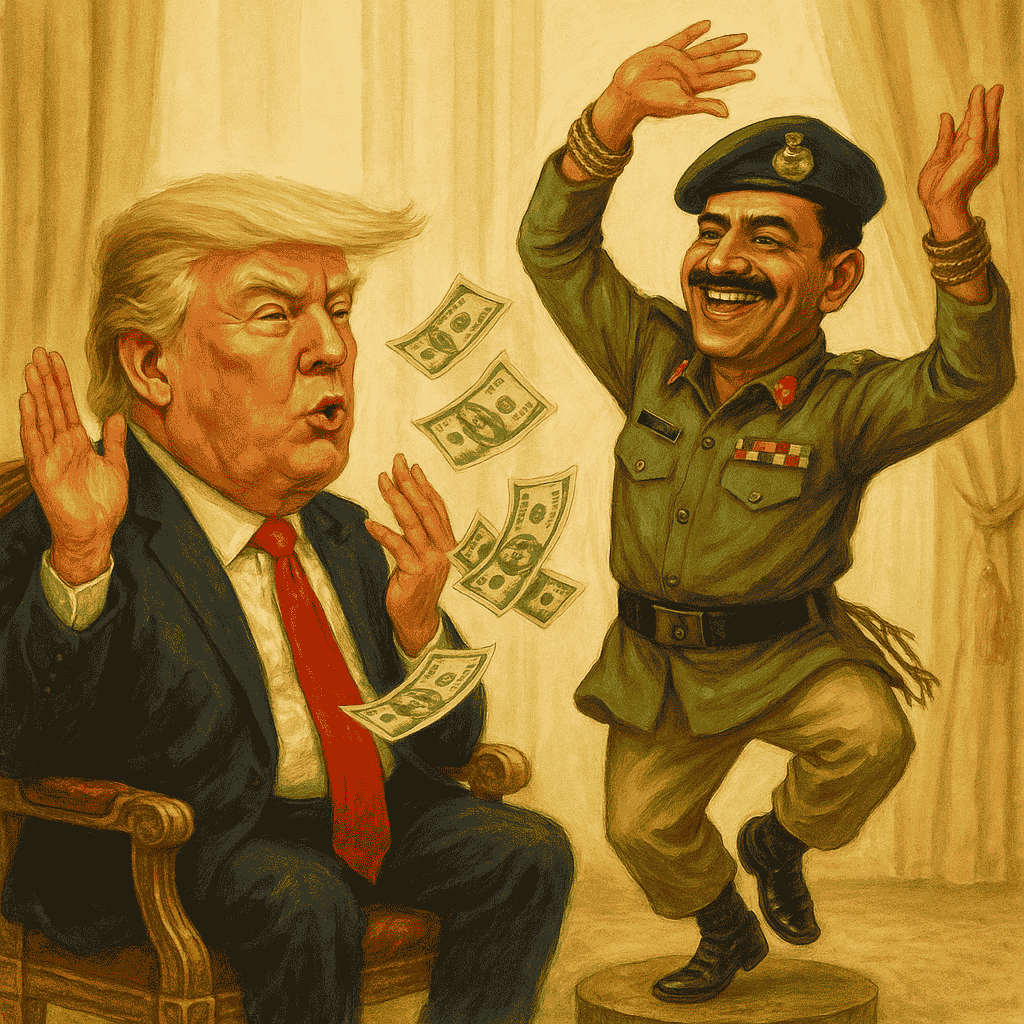Every country has military and Pakistan Military has a country. This statement is only vindicated by the fact that the Pakistan PrimeMinister was nowhere to be seen while Munir-Trump were having lunch.

In the high-stakes theatre of South Asian geopolitics, the United States, India, and Pakistan are once again entangled in a strategic triangle — one shaped by history, ambition, and shifting alliances.
“Geography gives no second chances, but diplomacy often plays the same hand twice.”
🍽️ Trump’s Lunch, Pakistan’s Leverage
Former U.S. President Donald Trump’s White House lunch with Pakistan’s Army Chief Asim Munir, was more than ceremonial. It signaled a revival of Cold War-style realpolitik, marked by nostalgia, optics, and short-term deals. Despite India’s denials, Trump’s claims of brokering ceasefires and using trade as leverage underscore a return to “deal over doctrine” diplomacy.
This pivot threatens decades of U.S.-India strategic alignment, particularly around counterterrorism and China containment — once hailed as one of Washington’s most successful post-Cold War recalibrations.
💸 From Rebuke to Reward: A U.S.–Pakistan Reset
Trump’s earlier bluntness — calling out Pakistan’s “double game” — had resonated well with New Delhi. But in a startling shift, his administration revived military aid to Pakistan, greenlighting $397 million for F-16 support, while U.S. officials began calling Pakistan a “phenomenal partner.”
This transactional reset serves America’s immediate goals: Iran intelligence, Afghanistan access, and keeping a foothold in China’s backyard. But for India, it threatens a values-based partnership and signals Washington’s growing ambivalence.
⚔️ India’s ‘New Normal’: From Restraint to Retaliation
“This is not a ceasefire. This is a pause.” — PM Modi
After the Pahalgam terror attack, India responded with Operation Sindoor — a decisive military strike signaling a doctrinal shift from strategic restraint to assertive retaliation. Governement frames this as a “new normal” — where diplomacy walks in lockstep with military resolve.
The message is clear: India will no longer play by old rules. But Beijing’s proximity to Islamabad raises fears of a two-front challenge.
🧊 Rawalpindi’s Hard State Doctrine
Pakistan, meanwhile, is doubling down on its military-first approach. Elevating Asim Munir to Field Marshal reflects a hardening of the state, centralizing power in the military, and sidelining civilian checks. At the same time, Pakistan is wooing Washington through trade deals, rare earth cooperation, and charm offensives — a classic case of geography meets guile.
🎭 Washington’s Balancing Act: Strategy or Shortcuts?
Today’s U.S. foreign policy seems torn between values and convenience. Its obsession with trade tariffs and tactical wins risks sidelining India’s Indo-Pacific role, even as strategic platforms like the Quad limp on.
By flirting with Pakistan while ignoring New Delhi’s red lines on Kashmir, the U.S. risks “re-hyphenating” India and Pakistan — a move antithetical to India’s global ambitions and sovereignty claims.
🧭 Why Pakistan Still Matters (To America)
Pakistan’s relevance rests on unchanging geography and sharp diplomacy. Bordering Iran, Afghanistan, and China, and situated at a regional crossroads, it remains a logistical and intelligence asset — especially as Washington recalibrates its stance on Iran and Central Asia.
Personal rapport — not policy alignment — often determines aid flows and access, keeping Pakistan in the game, despite its economic fragility.
🪙 Conclusion: Between Transactions and Trust
The U.S. must tread carefully. In a region bristling with nuclear arms, historical scars, and rising powers, short-term deals can undermine long-term stability. India seeks principled partnership. Pakistan seeks renewed relevance. The U.S. risks becoming a power pulled between idealism, realism, and impulsive diplomacy.
“Allies are chosen by choice, not by geography. But geography has a stubborn way of making its case.”


